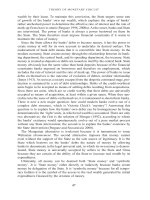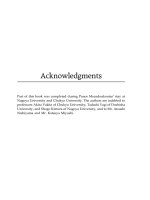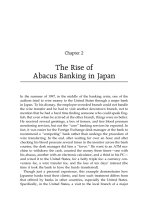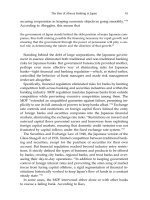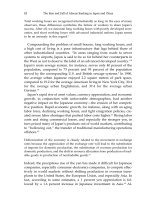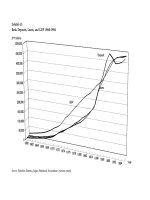The Rise and Fall of Abacus Banking in Japan and China phần 3 potx
Bạn đang xem bản rút gọn của tài liệu. Xem và tải ngay bản đầy đủ của tài liệu tại đây (577.79 KB, 22 trang )
Chapter 2
The Rise of
Abacus Banking in Japan
In the summer of 1997, in the middle of the banking crisis, one of the
authors tried to wire money to the United States through a major bank
in Japan. To his dismay, the employee-crowded branch could not handle
the wire transfer and he had to visit another downtown branch, not to
mention that he had a hard time finding someone who could speak Eng-
lish. But even when he arrived at the other branch, things were no better.
He received several greetings, a box of tissues, and free blood pressure
monitoring services, but not the ‘‘core’’ banking services he expected. In
fact, it was easier for the Foreign Exchange desk manager at the bank to
recommend a ‘‘competing’’ bank rather than undergo the procedure of
wire transferring. In the end, after waiting for over an hour and after
checking his blood pressure several times in the monitor across the bank
counter, the desk manager did him a ‘‘favor.’’ He went to an ATM ma-
chine to withdraw the cash, counted the money three times—one with
his abacus, another with an electronic calculator, and a third in his PC—
and wired it to the United States, for a hefty triple fee: a currency con-
version fee, a wire transfer fee, and the loss of ten days’ interest (the
time it took the bank to have the funds transferred).
Though just a personal experience, this example demonstrates how
Japanese banks treat their clients, and how such treatment differs from
that offered by banks in other countries, especially the United States.
Specifically, in the United States, a visit to the local branch of a major
20 The Rise and Fall of Abacus Banking in Japan and China
bank and a moderate fee are sufficient for wiring money overnight, all
over the world. But the difference between Japanese and U.S. and Eur-
opean banking extends beyond money-wiring procedures and fees to the
ways that Japanese banking performs its fundamental functions and
earns its income, and the ways that government bureaucrats supervise
the industry and control the behavior of bank managers.
In the United States, private banks are true for-profit institutions. Ac-
cording to prevailing corporate governance, individual and institutional
stockholders who appoint professional managers to oversee the day-to-
day operations own them. In this sense, managers are accountable to the
bank stockholders. They must enhance stockholder value or risk losing
their positions.
1
At the same time, bank managers must limit traditional
risks (liquidity and credit risks), market risks (foreign currency risk, in-
terest rate risk, liquidation risk, etc.), and operational risks. Government
regulators impose a number of constraints to limit competition in the
banking industry and the risks associated with it. The Glass-Steagall Act,
for instance, limits cross-state competition and competition between the
banking and securities industries. Yet government regulators do not
monitor the day-to-day operations of individual banks and control the
behavior of bank managers. This has been especially true since the late
to mid-1970s, when currency liberalization, financial deregulation, and
globalization weakened the Glass-Steagall Act and increased both market
opportunities and risks. In this sense, U.S. bank managers perform a dual
function—as accountants, monitoring fund flows in and out of the bank
treasury, and as credit risk analysts, evaluating the risk and returns of
investment alternatives.
In contrast to American banks, Japanese private banks are not true for-
profit institutions. According to the prevailing corporate governance,
bank stockholders appoint management to oversee day-to-day opera-
tions, but have little control over it.
2
Specifically, banks that are owned
by large corporations and operate under what is known as keiretsu re-
lations are not too concerned with profits, but rather with relations and
mutual obligations with other keiretsu members. In this form of ‘‘rela-
tional banking,’’ banks serve more as corporate welfare agencies, pro-
viding low-cost financing to their keiretsu clients who are also their
shareholders as compared to other clients, rather than as true, profit-
maximizing enterprises. Japanese banks are not overly concerned with
traditional banking risks either. Under a policy known as ‘‘overlending,’’
for instance, the BOJ has virtually eliminated liquidity risk.
Keiretsu relations, fast economic growth, and rising asset prices have
The Rise of Abacus Banking in Japan 21
also limited individual and systemic credit risk. Tight government reg-
ulation has limited competition among banks’ corporate clients, among
banks and the securities industries, and among banks themselves, re-
ducing market risks. Government regulation further monitors the day-
to-day performance of banks, controlling, in essence, the behavior of
bank managers. In contrast to their American counterparts, Japanese
bank managers basically perform only one function—that of accountants
or abacus bankers, who keep records of transactions and assign loans
according to government guidelines and keiretsu relationships rather than
according to the principles of credit risk management. In this sense, Jap-
anese banks have grown accustomed to deriving their income from a
thin interest rate spread rather than through investment risk manage-
ment. This has been particularly true in the first four decades that fol-
lowed the Occupation, an era of high economic growth and savings rates,
tight government regulation, and asset inflation.
Arguing this hypothesis in more detail, this chapter takes a closer look
at a number of structural facets of the ‘‘extended high-growth’’ era, from
the early 1950s to the late 1980s, and investigates how such facets nur-
tured abacus banking.
3
Specifically, the chapter reviews the sources of
Japan’s economic growth, business relations, and government policies
over the said period, and how they have provided a virtually risk-free
environment, giving rise to abacus banking.
Japan’s postwar economic expansion began with the economic reforms
of the Occupation, especially the breaking of zaibatsu groups, land re-
form, and democratization of the political system:
Probably the most important among the reform programs were land reforms and
the revision of the constitution, both of which have a lasting impact on Japanese
society, most likely because they found solid backing in the minds of Japanese
people themselves.
4
Occupation’s economic reforms were supplemented by post-Occupation
government policies, which included the importation of foreign technol-
ogy, the protection of domestic industry, U.S. investment and instant
access of Japanese corporations to the American market, and macroeco-
nomic stability.
5
In addition to Occupation reforms and post-Occupation government
policies, a number of demand and supply factors have contributed to
Japan’s economic growth. On the demand side, domestic demand
growth played a major role in accommodating economies of scale and
22 The Rise and Fall of Abacus Banking in Japan and China
sparking growth in the 1950s and 1960s. According to Denison and
Chung’s classic study on the sources of growth, a major factor in Japan’s
growth for the period 1950–1962 has been the economies of scale, a much
more important factor than in other industrialized countries.
6
A study
by Porter further supports this point:
Demand conditions proved to be one of the most important of the determinants
of national competitive advantage in Japanese industry. In a remarkable number
of industries in which Japan achieved strong positions, the nature of domestic
demand characteristics provided a unique stimulus to Japanese companies. The
domestic market, not the foreign markets, led industry development in the vast
majority of Japanese industries. Only later did exports become significant.
7
Exports played a role in the 1950s, but they became important much
later—indeed, after the first oil shock, and even then the growth of ex-
ports lasted for only ten years, until 1985, when the yen appreciation
forced Japan to switch to domestic demand growth.
8
Export demand
grew at 17 percent in 1976, 12 percent in 1977, 18 percent in 1980, and
14 percent in 1981; exports declined by 1.4 percent in 1986, 1 percent in
1987, and 0.5 percent in 1990, and they remained stagnant throughout
the mid-1990s. Domestic demand rose by 4.1 percent, 6.2 percent, and
4.6 percent for the corresponding years, and although at low rates, de-
mand picked up in the early to mid-1990s.
9
On the supply side, growth in inputs, that is to say, growth in the
labor force and in labor force participation, expansion of working hours,
gains in labor productivity, and growth in total factor productivity
(spread of new technology) account for Japan’s rapid economic growth.
In fact, employment rose at an annual rate of 1.3 percent between 1960
and 1973, 0.6 percent between 1973 and 1979, and 1.2 percent between
1979 and 1989. Between 1979 and 1988, labor productivity increased at
3.1 percent, compared to 0.9 percent for the United States and 1.9 percent
for Germany; between 1989 and 1993, labor productivity increased by
1.4 percent in Japan, compared to 1.5 percent for the United States and
0.3 percent for Germany. Between 1979 and 1988, total factor productiv-
ity increased at a rate of 1.8 percent, well above the corresponding rates
of 0.4 percent for the United States and 0.7 percent for Germany; between
1988 and 1993, total factor productivity in the United States increased by
2.4 percent in Japan, compared to 2.3 percent in the United States and
0.1 percent in Germany. Overall, for the period 1979–1995, Japan’s total
factor productivity increased by 1.2 percent annually, compared to 0.5
The Rise of Abacus Banking in Japan 23
Exhibit 2.1
Economic Plans: Fiscal Years, GNP Growth Target, and Average Annual
GNP Growth Achieved (1956–1992)
percent for the United States and 0.4 for Germany. It is these gains in
total factor productivity, a kind of technological catch-up, that have
pushed Japan well past the limitations of input growth.
10
In most Western societies, policy makers are preoccupied with con-
sumer prosperity, but not in Japan. In this country, production comes
before consumption, work before leisure, and corporation before family,
at least in the first three decades that followed the end of the Occupation.
‘‘Grow or perish’’—that is how the ‘‘Yoshida Doctrine’’ defined Japan’s
economic strategy in the postwar era. Reflecting this doctrine, all three
economic plans from 1958 to 1970 stated explicitly that maximum growth
was the most important goal (see Exhibit 2.1). The Income Doubling Plan
of 1959, for instance, called for high savings and investments as the ve-
hicles to achieving rapid technological innovations and high growth, as
did the 1958–1962 plan.
Pursuing the objectives of the Yoshida Doctrine, corporations, workers,
banks, and the government all joined forces to accomplish this objective.
Companies invested heavily in capital equipment, paid little in divi-
24 The Rise and Fall of Abacus Banking in Japan and China
Exhibit 2.2
Real GNP Annual Growth in Major Industrial Countries (1960–1987)
Sources: The Europa World Year Book 1992/94 (London: Europa Publications); OECD (1994a);
and IMF (1980).
dends, and emphasized sales and market share growth. Throughout the
1960s and the 1970s, for instance, gross domestic investment accounted
for 30–40 percent of GDP, compared to 13–18 percent in the United
States.
11
In 1990, Japanese companies had a payout ratio (the proportion
of earnings paid out as dividends) of 30 percent, compared to 54 percent
for U.S. companies and 66 percent for British companies.
12
At the same
time, companies developed close ties with enterprise unions that pro-
moted worker participation, training, joint consultation, flexible compen-
sation, and decision by consensus. For their part, workers demonstrated
discipline and cooperation, worked long hours, and saved a great deal.
In the mid-1980s, Japanese employees worked 15–20 percent more than
their American counterparts, and 25–30 percent more than their Western
European counterparts.
By the early 1980s, the objectives of the Yoshida Doctrine had been
achieved and even surpassed, and Japan had grown and flourished. For
the periods 1956–1960 and 1958–1962, Japan’s economy grew at 8.8 per-
cent and 9.7 percent, well above the corresponding 4.9 percent and 6.5
percent target levels (see Exhibit 2.2). For the period 1960–1973, the Jap-
anese economy grew at a rate of 6.3 percent, compared to the 2.5 percent
and 4.8 percent corresponding U.S. and OECD (Office of Economic Co-
operation and Development) growth rates. For the period 1974–1979, Ja-
pan’s economy grew at a slower rate of 3.6 percent, but again, above the
U.S. and OECD growth averages of 2.6 percent and 2.9 percent. Japan’s
superior performance continued for the periods 1980–1982 and 1983–
1987.
Though eventually services caught up and even surpassed manufac-
turing, for the most part the said period growth was manufacturing ori-
ented. Even as late as 1989, the service sector provided for 55.8 percent
The Rise of Abacus Banking in Japan 25
of the GDP and 59 percent of employment; the corresponding figures for
the United States were 68.8 percent and 72.5 percent. The industrial sec-
tor provided for 41.9 percent of the GDP and 34.6 percent of employ-
ment; the corresponding figures for the United States are 29.2 percent,
and 24.6 percent, respectively.
High GDP growth rates, accompanied by low inflation and unem-
ployment, have allowed Japanese consumers to enjoy rapid growth in
their real income. For the period 1950–1990, real incomes rose from
$1,230 (in 1990 prices) to $23,970 (a 7.7 percent average annual growth
rate), well ahead of the 1.9 percent growth of the United States, and 1.0
percent of Great Britain.
13
High economic growth rates, low unemploy-
ment, and a high per capita GDP placed Japan next to developed nations.
Japan’s preoccupation and success with high manufacturing-oriented
economic growth provided the country’s banks with lending opportu-
nities and a risk cushion, for a number of reasons. First, as discussed
earlier, high economic growth was associated with steady employment
and rising personal income and savings.
14
With the exception of the years
1981 and 1982, disposable income rose steadily throughout the period
1975–1988, especially in the late 1970s and the late 1980s, when real dis-
posable income rose in excess to 5 percent. Over the same period, savings
were close to 20 percent of disposable income.
15
In 1985, Japan’s savings
accounted for 18 percent of disposable income, compared to Canada’s
9.7 percent, France’s 12.6 percent, and the United States’s 4.9 percent.
16
High savings, in turn, provided a steady supply of deposit funds to
banks, especially in the absence of well-developed securities markets.
Every single working day, Japanese individuals and corporations generate over
a billion of dollars’ worth of savings. This excess cash rushes into domestic bank
accounts, stocks, insurance premiums, and real estate speculation, but even these
institutions cannot hold it all. Like water seeking its own level, a large amount
of it must flow abroad.
17
For the period 1954–1988, for instance, Japan’s financial intermediation
ratio increased fourfold, while the corresponding U.S. ratio merely dou-
bled (see Exhibit 2.3). For the same period, Japan’s indirect financial ratio
remained at around 0.70, above the corresponding U.S. ratio (see Exhibit
2.4). For the period 1960–1990, bank deposits stayed high, close to 70
percent of banks’ liabilities (see Exhibit 2.5).
A steady supply of deposits, in turn, allowed banks to keep their lend-
ing rates low, a factor that is often quoted as a source of competitive
Exhibit 2.3
Asset Accumulation and Financial Intermediation in Japan and the United States (1954–1988)
Source: OECD (1990/1991), p. 77.
Exhibit 2.4
Indirect Financing Ratio (1954–1988)
Source: OECD (1990/1991), p. 77.
Exhibit 2.5
Bank Deposits in Japan (1960–1996) (percent of total assets)
The Rise of Abacus Banking in Japan 29
advantage of the Japanese corporations against their American counter-
parts in the said period.
18
‘‘For Americans operating in many parts of
the world, the biggest problem in competing with the Japanese is not
price but the favorable financing terms that Japanese companies can offer
as a result of their low cost of capital and government guarantees.’’
19
Indeed, according to economists Cauly and Zimmer, the cost of capital
for a firm with factories with an average life of 40 years was 5 percent
in 1988 in Japan, compared to 10 percent in the United States, 8 percent
in the United Kingdom, and 5 percent in the former West Germany.
20
In
fact, Japanese lending was so low in the late 1980s that the spread be-
tween lending rates and deposit rates was negative, which (as will be
discussed in Chapter 4) is the root cause of the precipitation of the bank-
ing crisis.
Second, high growth and low financing rates fueled corporate invest-
ment and therefore created a steady demand for corporate loans. For the
period 1980–1990, for instance, bank loans in Japan almost quadrupled,
while U.S. bank loans merely doubled (see Exhibits 2.6 and 2.7). The
demand for corporate loans was particularly strong over the period un-
der consideration for another reason—the lack of direct financial markets
where a corporation could issue equity, as had been the case in other
countries, especially the United States. ‘‘Loan demand persistently ex-
ceeded supply in the bank loan market in that period, and especially
major banks such as city banks faced huge demands for their loans and
couldn’t meet all of them.’’
21
In this way, Japanese corporations have
relied on bank financing for their capital needs rather on securities fi-
nancing. ‘‘The banks have provided the bulk of corporate sector’s bor-
rowing needs. During the ‘high-growth’ era (prior to the first oil shock)
the domestic capital market was underdeveloped—neither corporations
nor the government relied on it for finance.’’
22
Specifically, in 1975, cor-
porate borrowing from banks ranged from 43 percent for large corpo-
rations to 46 percent for medium corporations and remained high in
1989, an issue that will be further addressed in Chapter 4.
In addition to high economic growth, the ability of Japanese banks to
extend corporate loans almost indefinitely is further reinforced by a long-
standing policy of the BOJ to provide liquidity to banks. Known as
‘‘overborrowing’’ or ‘‘overlending,’’ such policy ‘‘chronically extended
more credit, either by lending and/or by purchase of securities, than they
acquired from deposits or their own capital. The gap was filled primarily
by relying on borrowings from the BOJ.’’
23
This means that the BOJ vir-
Exhibit 2.6
Bank Loans in Japan (1960–1996) (percent of total assets)
Exhibit 2.7
Bank Loans in the United States (1980–1995) (percent of total assets)
32 The Rise and Fall of Abacus Banking in Japan and China
tually eliminated liquidity risk, a traditional banking risk. Adams and
Hoshii note:
Due to the readiness of the Bank of Japan to give credit to the commercial banks,
liquidity is of practical significance in Japanese banking lending. Hence, the fi-
nancial managers of the country permitted the so-called overloan situation not
only to arise but to continue for long periods without fear of panic or insol-
vency.
24
The BOJ policy of overlending can be traced back to the turn of the
century, as a vehicle of financing the country’s industrialization.
In expanding their loan business, the most powerful banks were able to borrow
at special rates from the Bank of Japan, while smaller banks borrowed from the
major banks. Through borrowing from the Bank of Japan, the commercial banks
were enabled to make loans to industrial enterprises at levels well above those
permitted by their own liabilities.
25
At any rate, permitting ‘‘overloan’’ to continue for long periods, the
Japanese private banking system as a whole enjoyed seigniorage income,
(i.e., just by creating money). In this sense, ‘‘overloan’’ is both a cause
and a consequence of Japan’s high economic growth. It is also a cause
and a consequence of government regulation of financial markets and
close relations between banks and business firms.
Over-loans of commercial banks are fundamentally a result of the high growth
rate of the Japanese economy. In post-war Japan, business firms have invested
at a rapid rate, so that their demand for funds has been extremely strong. In
spite of this development, the capital market has lagged, so that business firms
have had to procure funds by borrowing from commercial banks. Under these
circumstances, close relationships have tended to develop between commercial
banks and business firms. Thus banks have been willing to meet this demand
for funds, and in consequence they have been chronically short of cash and liquid
reserves. The cash deficiency has been made good by borrowing from the BOJ
or from the call money market.
26
Third, high economic growth and successful overseas expansion cre-
ated a steady flow of revenue, earnings, and cash flow for Japan’s large
corporations, especially in the late 1980s. The profit-sales ratio increased
steadily from nearly 5 percent in 1984 to nearly 7 percent by 1989, while
the net rate of return on corporate assets increased from nearly 0 percent
The Rise of Abacus Banking in Japan 33
in 1983 to nearly 15 percent in 1989.
27
Over the same period, cash flow
increased from 4 percent to nearly to 6 percent.
28
Steady earnings and
cash flow in turn allowed Japanese corporations to repay loans to banks.
Fourth, high economic growth was accompanied by asset inflation,
especially land inflation in the major city areas. Between 1955 and 1989,
land prices at the national level rose sixteenfold, while land prices in the
six major city areas rose almost thirtyfold.
29
To be more specific, land
price inflation was not just the result of economic growth but also the
result of urbanization and population density, tax law, and strict zoning
laws that acted as price supports.
30
Equity price rises were as dramatic,
especially in the bubble years. Between 1985 and 1989, for instance, To-
kyo share prices and land prices in the six major cities rose by 180 per-
cent.
31
In either case, as stocks and land in particular are used as loan
collateral, higher prices expand the lending opportunities of banks).
Wood States:
So a rising stock market literally increases banks’ ability to lend. It also increases
the net worth of the corporate sector because of the still widespread system of
cross shareholding where companies own shares in one another, not for the pur-
poses of investment but to cement long-standing business relationships.
32
Higher land and equity prices further provide another credit risk cushion
for Japanese banks, in case a loan recipient does not generate sufficient
cash value to repay its loans. ‘‘In the rare event a borrower went under,
his land collateral was as good as gold anyway since legions of land-use
restrictions acted as virtual government price supports.’’
33
Simply put,
as long as the assets in collateral are rising in price, banks have little to
be concerned about the quality of such assets.
Fifth, as economic growth in the 1950s and the 1960s was concentrated
in manufacturing, bank lending was extended to large corporations with
tangible assets placed as a collateral, an important requirement for Jap-
anese lending:
34
Most of the important types of financial transaction in Japan, including corporate
debenture issue, bank lending, and interbank transactions, require the provision
of collateral. This practice is unique to Japan; in the other industrialized countries,
the provision of the collateral is decided on a case-by-case basis between the
parties to the transaction, and, in fact, there are many cases in which collateral
is required.
35
34 The Rise and Fall of Abacus Banking in Japan and China
This means that Japanese bankers did not make a special effort to ap-
praise and assess the value of well-known companies with highly visible
products and assets, especially as long as both sales and asset prices grew
exponentially. Simply put, Japanese bankers did not have to possess any
special skills or apply any advanced risk management techniques to eval-
uate the creditworthiness of loan applicants; the use of an abacus cal-
culator was sufficient. Besides, a steady, long-term economic growth
allowed Japanese banks to conceal losses in bad years and make up for
them in good years.
In short, ‘‘overlending,’’ robust, manufacturing-oriented economic
growth, high savings, and asset inflation allowed the Japanese banking
system as a whole to enjoy seigniorage income, limiting its exposure to
traditional banking risks at the same time. As long as the BOJ provided
sufficient liquidity, as long as the economy grew, as long as savings
continued to pour into the banking system, and as long as assets placed
for collateral were tangible and rising in value, Japanese bank managers
did not have to be concerned with traditional banking risks. But Japanese
managers did not have to be concerned about risk for another, funda-
mental reason. In a country where business-to-business and business-to-
government relations come before profit, individual risk becomes irrel-
evant in evaluating creditworthiness and managing bank portfolios.
To be fair, business-to-business relations are an important factor in the
evaluation of prospective clients’ creditworthiness in every country
around the world. Yet in most developed countries, to avoid market
concentration and control, government regulation separates bank gov-
ernance from corporate governance. Banks cannot be major shareholders
of corporations, and corporations cannot be the major stockholders of
banks (i.e., corporate directors do not sit on the boards of banks, and
bank directors cannot sit on the boards of corporations). In the United
States, for instance, banking and anti-trust regulation prohibits banks
from holding equity positions. Anti-trust regulation further limits cross-
corporate holdings.
The separation of bank governance from corporate governance allows
corporations and banks to pursue independently the interests of their
own stockholders; the interests of bank shareholders and the interests of
the shareholders of their corporate clients may be in conflict with each
other. Higher lending rates, for instance, may benefit the bank share-
holders, but they may hurt the shareholders of their corporate clients.
Banks may further decide to scale back credit to customers whose cred-
itworthiness has diminished, due, for example, to deterioration in their
The Rise of Abacus Banking in Japan 35
economic or financial situation. In addition, in most countries around the
world, management is accountable to its stockholders, and strict disclo-
sure laws allow the general public to evaluate banks as depository and
investment institutions.
In Japan, the important factor in evaluating prospective clients and
extending credit to them is business-to-business relations, especially re-
lations between banks and their clients, often supported by long-lasting
cross-ownership holdings.
36
Increasingly, business relations among companies, be they industrial or financial,
became cemented by cross-shareholding arrangements. Over time, an intricate
web of cross-holding emerged. By 1955, cross-shareholding was at 25 percent of
outstanding stocks listed on the Tokyo Stock Exchange and, by 1960, at about 40
percent.
37
In 1988, banks held 17 percent of the Tokyo Stock Exchange’s listed
shares, while corporations held 44 percent of the bank-listed shares.
38
A
1995 OECD survey further finds that in Japan, banks owned 26.7 percent
of stocks, compared to 0.3 percent in the United States, 12 percent in
Germany, 4.3 percent in France, and 0.9 in the United Kingdom.
39
Combined with an implicit commitment of the large corporations to
enterprise unions to warrant lifetime employment to their regular em-
ployees, cross-ownership holdings make it more convenient, even man-
datory, for banks to focus on a strategy of money creation—low-interest
volume lending. Low-interest volume lending allows keiretsu members
to aggressively expand their sales and market shares to provide stable
employment and high wages for their employees.
40
In this way, banks
pursue the interests of their stakeholders rather than their stockholders,
a practice that can be traced back to the National Mobilization Law,
introduced in the late 1930s, as a way of promoting social peace between
labor and management.
41
According to Noguchi,
Before the war, companies primarily pursued the interests of shareholders, and
direct financing—obtaining funds through the financial markets—was much
more prevalent. That began to change as the nation prepared for war. In 1938
came the national mobilization law, which restricted shareholders’ rights and
prompted companies to place priority on keeping workers happy. This was de-
signed to instill a sense of belonging and security, thus contributing to worker
productivity.
42
36 The Rise and Fall of Abacus Banking in Japan and China
Relations between banks and their corporate clients could be described
as ‘‘ ‘a system of corporate financing and governance,’ by emphasizing
the reciprocal delegation of monitoring among banks and the subordi-
nation arrangement in the event borrowing firms experience financial
distress.’’
43
As a result, commercial banks, in particular city banks, have
had very close relationships with their business customers. City banks
often serve as ‘‘main banks,’’ arranging for syndicated loans to their
corporate clients, which by definition diversify the risk exposure of each
syndicate bank to a particular corporate loan. As of 1994, for instance,
Sakura Bank served as a main bank to 132 firms, Fuji Bank to 132 firms,
and Tokai Bank to 100 firms.
44
Each main bank is
committed to stabilize the business performance of a borrowing firm through
bank finance and control, while it maintains the right to intervene in the borrow-
ing firm’s management. That is, to fulfill the firm’s demand for bank loans and
to keep loan-risk diversion, the main bank organizes a ‘‘de facto’’ loan consor-
tium by implicitly guaranteeing the creditworthiness of the firm to other non-
main banks or by allowing a free-ride for non-main banks in monitoring
activities.
45
At times, relationships between main banks and their business clients
are so close that they meddle in one another’s business and even cor-
porate governance, which has contributed to overlending.
Dependent for their own success upon the success of the firms of their group,
the banks typically found that it made sense both to support and supervise them,
and adopted the practice of sending representatives to the members’ boards of
directors to monitor the firms’ activities and to provide information and advice,
as well as funds.
46
A bank too closely linked with a particular business firm may easily be involved
in the latter’s competition with other groups, so that banks are liable to extend
credit too freely; it has to be recognized that this has been a factor making for
overlending of the economy.
47
The melding of governance of corporate and lending institutions is
permitted by the absence of sound corporate governance laws, and the
lack of disclosure laws in essence turns the MOF into the de facto guar-
antor of the soundness of the banking industry.
The Rise of Abacus Banking in Japan 37
Among the industrialized countries, disclosure of a bank’s books is one of the
most important resources the public has for evaluating a bank as an equity in-
vestment or as a reliable depository institution. In Japan, it could be argued, the
MOF’s implicit guarantee against bank failure is the functional equivalent of full
disclosure.
48
The rather unusual corporate governance further creates a peculiar
situation. First, banks serve as corporate welfare institutions rather than
as true for-profit institutions. As the leader of the keiretsu group, Japanese
banks have turned to the financing arm of the corporate members and
must be prepared to finance their credit needs, irrespective of the eco-
nomic situation of each corporate member or the feasibility of the pro-
jects pursued. This function of Japanese banks is reflected in the low
interest rate spread, often 50 basis points or about 1 percent of the banks
assets, compared to 3.8 percent of U.S. banks, 3.6 percent of Italian banks,
and 3 percent of U.K. banks.
49
A low interest rate income margin and a
low return on equity (ROE) in turn means that Japanese banks collect
little, if any, premium for risk. In 1996, for instance, Japanese banks
earned a net rate of ROE of 2.1 percent, well below a corresponding 20.7
percent ROE of their U.S. counterparts (see Exhibit 2.8).
The inability of banks to raise lending rates supports and reinforces
the policy of overlending and leaves Japanese banks vulnerable in case
of loan defaults, an issue that will be addressed in subsequent chapters.
Second, keiretsu relations serve as another buffer against liquidity risk
for Japanese banks. Should a member bank or a finance corporation face
liquidity problems, keiretsu members often will come to their rescue. Con-
versely, keiretsu relations oblige banks to come to the rescue of inefficient
members that the market would have otherwise washed away. Yamaichi
Securities and Yasuda Trust are two examples. In 1965, for instance, Fuji
and Mitsubishi Bank, in collaboration with the MOF and the BOJ, res-
cued Yamaichi Corporation, a member of the same keiretsu group. In
February 1998, Fuji Bank, the main bank for the Fuyo keiretsu group,
poured in close to $850 million to rescue Yasuda Trust, a member of the
same keiretsu, while for the period 1978–1985, close to 52 percent of all
firms in financial distress were rescued by their ‘‘main bank.’’
50
Third,
close keiretsu relations and the system of mutual obligations reinforce
secrecy, non-disclosure, and bogai (i.e., detour the losses in subsidiaries
set up for this purpose). Keiretsu members are reluctant to reveal the
financial difficulties of their members, and they make bank managers
accountable to other keiretsu members rather than to the stockholders.
Exhibit 2.8
International Comparison of Bank Profitability
Source: OECD (1995), p. 58.
The Rise of Abacus Banking in Japan 39
Besides, as was discussed earlier, in a fast-growing economy, concealing
short-term losses in bad years is not a problem; they will be made up in
good years.
In short, main bank-centered keiretsu relations and loan syndicates as-
sociated with it diversify corporate lending and therefore limit credit
risk. At the same time, keiretsu relations limit the freedom and ability of
Japanese bank managers to manage risks (i.e., to allocate credit according
to the creditworthiness of their prospective clients). They further rein-
force a volume-lending strategy that boosts seigniorage income, a strat-
egy that eventually led to overlending and to the banking crisis, which
will be addressed in the following chapters. But what limits the freedom
of Japanese bank managers to manage risk the most is their close rela-
tions with the government regulators.
Ever since the Meiji Restoration, good relations with bureaucrats were
the necessary and often the sufficient condition for pursuing any kind of
business in Japan. In the early days of the Restoration, for instance, the
Japanese government assisted business to import foreign technology
from abroad. In some cases the government even set up model factories,
which in turn were handed over to the private sector. In addition, the
government provided industrial guidance (i.e., it chose the industries
that the private sector should pursue and set up the parameters and
incentives to ensure that the private sector would follow through). In
this way, each sector of the economy developed
a clientele relation to a ministry or agency of the government. The ministry by
statute can wield various sticks and carrots in dealing with the economic sector,
but it also holds a general implied administrative responsibility and authority
that goes well beyond what is customary in the United States, though it may
come close to French practice.
51
MITI, for instance, formulated ‘‘visions’’ for the future of the Japanese
economy and chose to promote the industries that served such visions.
The Ministry of Postal Savings in turn allocated the appropriate postal
funds to finance the industries pursued. For its part, the mighty MOF
issued its own directives to private banks to supplement the financing
of the said industries and stood ready to rescue such industries in per-
iods of economic decline. In this way, the Japanese government’s inter-
vention in the banking industry extends beyond the conventional
regulation, which is the case in other countries. It is an intervention in
the daily functioning of banks and corporations, which in essence limits
40 The Rise and Fall of Abacus Banking in Japan and China
banking risks and controls the behavior of bank managers. According to
Adams and Hoshii,
The most important institution in the field of banking and credit, however, is the
Ministry of Finance, which shapes fiscal and monetary policies, supervises not
only all credit institutions but also the financial behavior of all corporations, collects
taxes and customs duties, controls foreign exchange, and has a decisive voice in
the approval of foreign investment in Japan and Japanese investments overseas.
52
(emphasis added)
The active intervention of government regulators in the economy and
the meddling with corporate governance continued well after Japan was
transformed to an advanced developed country, until the burst of the
bubble economy in the late 1980s, when the government took measures
to protect domestic industry from foreign competition and to control
foreign currency fluctuations. Specifically, protectionism has taken sev-
eral forms and faces. In the late 1940s and early 1950s protectionism was
in the classical form, the infant industry type. Imports of commodities
and resources that would threaten Japan’s infant industries were for-
mally restricted. But as the Japanese economy took off and Japanese
products captured the world markets, formal import barriers were re-
placed by informal ones that delayed the pace or even blocked foreign
access to many industries until domestic companies developed and
flexed sufficient competitive muscle. Take the case of semiconductors,
for instance. After failing to promote the domestic computer industry in
the mid-1960, MITI introduced stiff trade barriers for foreign companies.
Permits for the establishment of foreign subsidiaries and the import of
computer microchips were denied, and Japanese executives were even
discouraged from working for foreign computer companies.
53
In addition, MITI continued its pre-war policy, assisting industries in
recovering from the economic stagnation that followed the oil and yen
shocks. Under the Temporary Act for the Specially Designated Indus-
tries, for instance, MITI provided the incentives to persuade companies
affected by the oil shock to reduce capacity and transfer resources to
new business. MITI has further been instrumental in bringing together
corporations for the development of technological applications and cop-
ing with the two oil shocks and the yen shock. In this way, ‘‘unlike
Western governments, which function as regulators of industry, the Jap-
anese bureaucracy serves as a facilitator, an organization dedicated to



